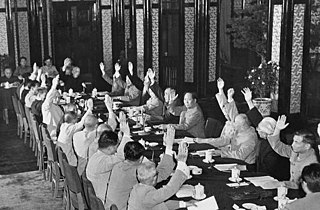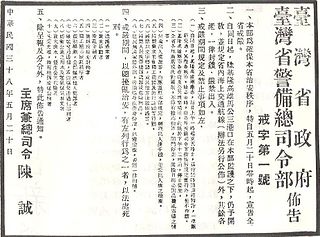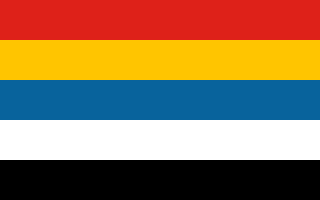See also
- Constitution of the Chinese Communist Party
- Additional Articles of the Constitution of the Republic of China, amendments to the 1947 Constitution promulgated in Taiwan
Constitution of China (1982) is the supreme law of the People's Republic of China.
Constitution of China may also refer to the historical constitutions:

The president of the Republic of China (ROC), also known as the president of Taiwan, is the head of state of the Republic of China, commonly known as Taiwan, as well as the commander-in-chief of the Republic of China Armed Forces. Before 1949 the position had the authority of ruling over Mainland China, but after communist victory in the Chinese Civil War, the remaining jurisdictions of the ROC have been limited to Taiwan, Penghu, Kinmen, Matsu, and smaller islands.

The National Assembly was the authoritative legislative body of the Republic of China, from 1947 to 2005. Along with the Control Yuan and the Legislative Yuan, the National Assembly formed the tricameral parliament of the Republic of China.

The Constitution of the Republic of China is the fifth and current constitution of the Republic of China (ROC), ratified by the Kuomintang during the Constituent National Assembly session on 25 December 1946, in Nanking, and adopted on 25 December 1947. The constitution, along with its Additional Articles, remains effective in ROC-controlled territories.
A provisional government, also called an interim government, an emergency government, a transitional government or provisional leadership, is a temporary government formed to manage a period of transition, often following state collapse, revolution, civil war, or some combination thereof.

The 1954 Constitution of the People's Republic of China was adopted and enacted on September 20, 1954, through the first session of the First National People’s Congress in Beijing. This constitution was amended and formulated on the basis of the Common Program of the Chinese People's Political Consultative Conference, which served as a provisional constitution in 1949, and is the first constitution of the People's Republic of China. The Constitution of the People's Republic of China is the fundamental law of the People's Republic of China and has the highest legal effect.
The 1975 Constitution of the People's Republic of China was promulgated by the 4th National People's Congress. The offices of Chairman and Vice-Chairman were officially scrapped under the Constitution after almost 7 years of functional non-existence since the purge of Liu Shaoqi.
The Chinese Peasants' and Workers' Democratic Party (CPWDP) is one of the eight minor political parties in the People's Republic of China under the direction of the Chinese Communist Party.

The Taiwan Area, fully the "Taiwan Area of the Republic of China", also the free area of the Republic of China, the "Tai-Min Area ", is a term used to refer to the actual-controlled territories of the Republic of China, usually called "Taiwan". It has been in official use since the Additional articles of the Republic of China constitution took effect to end temporary anti-communist provisions on 1 May 1991. The term is also used in the 1992 Cross-Strait Act.
The Temporary Provisions Effective During the Period of National Mobilization for Suppression of the Communist Rebellion provisions of the Constitution of the Republic of China were effective from 1948 to 1991 and amended four times by the Central Government of China. They effectively nullified the constitution and established martial law in Taiwan, where civil and political freedoms were curtailed. The official rationale for the provisions was the ongoing Chinese Civil War. However, with the demise of the Kuomintang single-party system, the provisions were repealed.

The Nationalist government, officially the National Government of the Republic of China, refers to the government of the Republic of China from 1 July 1925 to 20 May 1948, led by the nationalist Kuomintang (KMT) party.

The Provisional Constitution of the Republic of China was the constitutional law of the Republic of China during the tutelage period. It was the second constitutional law since the Qing Empire was renamed and restructured as the Republic of China. It was enacted by the National Government in May 1931 and was abolished naturally until December 25, 1946, after the implementation of the Constitution of the Republic of China. However, it was never promulgated by the competent authority.

The Government of the Republic of China, is the national authority whose actual-controlled territory consists of main island of Taiwan (Formosa), Penghu, Kinmen, Matsu, and other island groups, collectively known as Taiwan Area or Free Area. A unitary state, the ROC government, under the current constitutional amendments, is run by a de facto semi-presidential system, consists of the presidency and five branches (Yuan): the Executive Yuan, Legislative Yuan, Judicial Yuan, Examination Yuan, and Control Yuan. The president is the head of state, with the premier as the head of government, currently ruled by the Democratic Progressive Party (DPP) since 2016. Since the 2005 amendments of the Additional Articles of the Constitution, the Legislative Yuan has been the de facto unicameral parliamentary body of the country.
The Constitutional history of the People's Republic of China describes the evolution of its Constitutional system. The first Constitution of the People's Republic of China was promulgated in 1954. After two intervening versions enacted in 1975 and 1978, the current Constitution was promulgated in 1982. There were significant differences between each of these versions, and the 1982 Constitution has subsequently been amended several times. In addition, changing Constitutional conventions have led to significant changes in the structure of the Chinese government in the absence of changes in the text of the Constitution.

Martial law in Taiwan refers to the periods in the history of Taiwan after World War II, during control by the Republic of China Armed Forces of the Kuomintang-led regime. The term is specifically used to refer to the over 38-year-long consecutive martial law period between 20 May 1949 and 14 July 1987, which was qualified as "the longest imposition of martial law by a regime anywhere in the world" at that time.
Period of mobilization for the suppression of Communist rebellion is a political term used by the Kuomintang-led government of the Republic of China to indicate the country's entering into a state of emergency with the raising Chinese Civil War. The term aimed to mobilize the people and resources under Kuomintang's control to fight with the Chinese Communist Party rebellion.

The Republic of China (ROC) began as a sovereign state in mainland China on 1 January 1912 following the 1911 Revolution, which overthrew the Manchu-led Qing dynasty and ended China's imperial history. From 1927, the Kuomintang (KMT) reunified the country and ruled it as a one-party state and made Nanjing the national capital. In 1949, the KMT-led government was defeated in the Chinese Civil War and lost control of the mainland to the Chinese Communist Party (CCP). The CCP established the People's Republic of China (PRC) while the ROC was forced to retreat to Taiwan and retains control over the "Taiwan Area"; the political status of Taiwan remains in dispute to this day.
Republic of China is the official name of Taiwan, a country in East Asia.